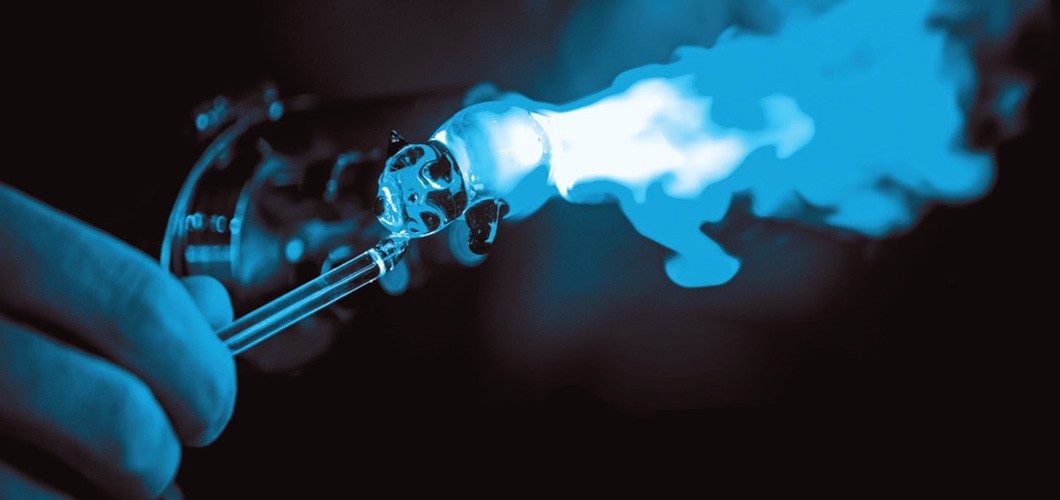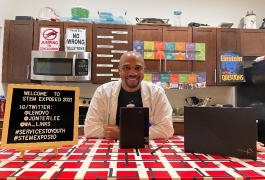The Glass Guru
By Michael Tinnesand

Michael Souza’s entire career has been devoted to glass, a product that no chemistry student or practitioner can live without. He is a professional glassblower for Princeton University, and his experience in the field spans 40 years—first in industry and then in academia. He began his career as an apprentice at H. S. Martin, a company that makes custom glassware for science and industry.
How did you become interested in glassblowing?
My father was in the industry, so it was mostly by heritage that I got into the business. When I was young, he would take my siblings and me to his workplace and we were given various tasks—mostly menial work, such as sweeping up or cleaning equipment. But later we got to play with glass, and I began to learn some of the basics about how it behaves.

How does one go about studying glassblowing?
When I started glassblowing 40 years ago, it was not common to earn any kind of academic degree as part of an apprenticeship. It is much more common now for students to get some sort of academic background in chemistry, physics, and/or materials science as part of their entry into the profession.
Today, several two-year colleges offer glassblowing degrees, although many of them focus on glassblowing as an art. The most well known school in the United States for a scientific glassblowing degree is Salem Community College, in New Jersey. It offers a two-year Associate in Applied Science degree in Scientific Glass Technology, which provides the necessary skills and techniques to construct glass apparatus for scientific research in university laboratories as well as industrial research and production.
After graduating from a two-year program, students face a 7000–8000-hour apprenticeship period (approximately 4–6 years) to become an experienced tradesperson. It will take a decade more of experience before someone is considered a master glassblower.
The University of Montana Western, in Dillon, is the only school in the country to offer a bachelor’s degree with a specialization in Scientific Glassblowing, a relatively new program.
Alfred University, in New York, is the only school in the United States that offers a graduate program in Glass Science. This program goes well beyond basic scientific glassblowing and covers aspects of materials science and engineering for master’s and Ph.D. degrees.
What is an apprenticeship like? How is it different from an internship?
In my experience, apprentice positions combine work and training. The kind of training you get is highly dependent on the type of industry you are working in. In the glassblowing field, you get some help and instruction. It is not like formal school. There are no grades or testing, no set standard curriculum. You get the training you need to be a productive worker, and you are expected to perform like other employees. I found I had to move to several different companies during my apprenticeship to get the breadth of experience I was after.
Internships are similar, but not as rigorous or lengthy. They are usually tied to part of a broader education plan and aimed at giving the student some practical experience in a job. They are often unpaid, but that varies.
What types of jobs did you have in industry?
When I started 40 years ago, I was involved in the production of glass vacuum tube devices that were used in electronics. This was before the invention of solid-state transistors, so every radio, television, and amplifier used vacuum tubes.
This changed as old vacuum tube technology was replaced by semiconductors. I worked with an apparatus used to create silicon wafers and then process them into chips. We did a lot of work with pure quartz glass, an exotic form of glass that is 99% pure silica and can withstand temperatures of 6000–8000 °C. It is also very stable thermally. It is used to make glass crucibles, trays, and wafer holders (called boats) used in microchip processing.
Glassblowing, by the numbers
Current employment: 41,320
Average hourly wage: $16.25
Job openings per year: 4200
State with the most glassblowers: California
Top industry employer: manufacturing
How is your work in academia different from (or the same as) your work in industry?
Industry jobs are driven by the bottom line of profit or loss. An apparatus is only produced if there is a proven market and established production methods that indicate it will make money. In academia, the technology takes priority over cost. Scientific research is devoted to making new discoveries, and that sometimes means creating equipment that is also new and has never been made. It is impossible to quote a price in advance for making something that has never been made. Materials still have to be made at a reasonable cost, but the science doesn’t move forward unless the right tools can be created.
Has the reliance on glassblowers by universities and research laboratories changed over the course of your career?
It was once very common for large university chemistry departments to have a dedicated scientific glassblower on staff. That is much less common now. There is a wider range of relatively inexpensive glass labware that is available off the shelf, and new materials have been developed to replace glass in some cases.
The work in academia has evolved to where the work is spread over several different departments and disciplines. At Princeton University, I work with physicists, biologists, biochemists, materials scientists, and others. Because the work is spread out, that can make it more difficult to administer and budget.
How do you go about a project—from idea to design to completion?
It always starts with ideas from the researcher and the needs they have for their experiments. Although they know the requirements for the end of the job, they are often unsure how to get there. By working together, we devise a plan that involves the types of materials and techniques I have available to create a device that meets their needs. Project designs rarely come in complete at the start. If things were that simple, the researcher could work with standard equipment that is available from regular product lines.
What is the most interesting glasswork you’ve done?
I’ve done recent work on making glass cells for a nuclear targeting experiment. The challenge of the job was to make the cells as thin as possible, with a wall thickness in the range of 20 micrometers (about one-fifth the thickness of a human hair), but still strong enough to withstand 300 psi (more than 20 atm) without bursting. The cells are all handblown by me. It required a series of tests to create the cells and then pressure-test them. If none exploded, it meant that they were still too thick. So we went on to the next thinnest one we could make.
What have you learned about the nature of glass in your experiences with glassblowing?
The most important lesson is that every ingredient that goes into the making of glass contributes to its final properties. There is infinite variety in the various formulations that can be made. Much of the materials science about the fundamental nature of glass is still poorly understood, and we are still learning how we can make glass that best suits our specific needs for different applications.
What do you find most rewarding about scientific glassblowing?
The opportunities available are as diverse and interesting as science itself. I find it very rewarding to work with researchers who have an idea of the apparatus they need to work on their experiments. It is a matter of creative teamwork between them and me. They know what they need for the science, and I know what is possible to design and create based on my knowledge of the materials science and my ability to work with glass and other substances. I’ve had the chance to participate in some of the most exciting research ever, from detecting magnetic fields on Europa (a moon of the planet Jupiter) to the search for dark matter in the universe. It is great to help in the work of creating new knowledge and the discovery of new ideas. This is a field where you can apply every bit of your scientific knowledge and curiosity over the course of your career.
This story is adapted from "How Glass Changed the World " featured in the October/November 2018 issue of ChemMatters Magazine.
Read more profiles at
College to Career
About the Author
Michael Tinnesand is a science writer and education consultant who lives in Portland, OR.




